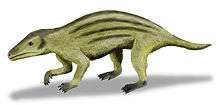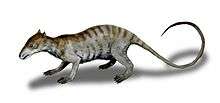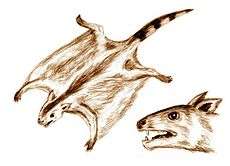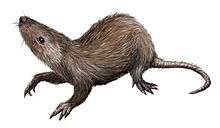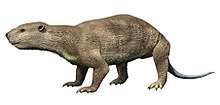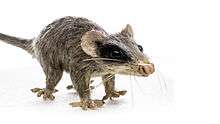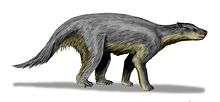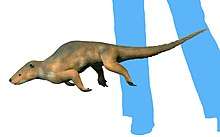Cimolodon
Cimolodon is a genus of the extinct mammal order of Multituberculata within the suborder Cimolodonta and the family Cimolodontidae. Specimens are known from the Late Cretaceous of North America.
| Cimolodon Temporal range: Late Cretaceous | |
|---|---|
| Scientific classification | |
| Kingdom: | Animalia |
| Phylum: | Chordata |
| Class: | Mammalia |
| Order: | †Multituberculata |
| Family: | †Cimolodontidae |
| Genus: | †Cimolodon Marsh, 1889 |
| Species | |
Systematics
The genus Cimolodon was named by Othniel Charles Marsh in 1889. Kielan-Jaworowska & Hurum (2001) noted that Cimolodon seems to be more closely related to members of their "Paracimexomys group than to other ptilodontoideans.[3]
Species
Cimolodon electus (Fox R.C. 1971) is known from the Upper Cretaceous of the Upper Milk River Formation in Alberta, Canada. Possible finds have been reported from New Mexico.[4]
Cimolodon nitidus (Marsh O.C. 1889) is known from Late Cretaceous strata of the Lance Formation of Wyoming, Utah, Montana and South Dakota (United States and Canada). Synonyms include Allacodon lentus (Marsh 1889); Allacodon rarus (Marsh 1892); Cimolomys bellus (Marsh 1889); Cimolomys digona (Marsh 1899); Cimolomys nitidus; Halodon serratus (Marsh 1889); Nanomyops minitus (Marsh 1892); Nanomys minitus (Marsh 1889); and Ptilodus serratus (Gidley 1909). Cimolodon pervus (Marsh O.C. 1892) is also known from the Upper Cretaceous Lance Formation of Wyoming.[5][6]
Cimolodon similis (Fox R.C. 1971) is known from the Late Cretaceous (Santonian-early Campanian) of Alberta and Utah.[7][8] C. wardi is known from the Wahweap Formation of Utah.[9]
Cimolodon akersteni is known from the Cenomanian-age Wayan Formation of Idaho.
References
- S. L. Donohue, G. P. Wilson, and B. H. Breithaupt. 2013. Latest Cretaceous multituberculates of the Black Butte Station local fauna (Lance Formation, southwestern Wyoming), with implications for compositional differences among mammalian local faunas of the Western Interior. Journal of Vertebrate Paleontology 33(3):677-695
- Weaver, Lucas N.; Wilson, Gregory P.; Krumenacker, L. J.; McLaughlin, Kayla; Moore, Jason R.; Varricchio, David J. (2019). "New multituberculate mammals from the mid-Cretaceous (lower Cenomanian) Wayan Formation of southeastern Idaho and implications for the early evolution of Cimolodonta". Journal of Vertebrate Paleontology: e1604532. doi:10.1080/02724634.2019.1604532.
- Kielan-Jaworowska Z. & Hurum J.H. (2001). Phylogeny and Systematics of multituberculate mammals. Paleontology 44, p. 389-429.
- L. J. Flynn. 1986. Late Cretaceous mammal horizons from the San Juan Basin, New Mexico. American Museum Novitates 2845:1-30
- Marsh (1889), "Discovery of Cretaceous Mammalia." Am. J. Sci. (3), 38, p. 177-180.
- Marsh (1892), "Discovery of Cretaceous Mammalia. Pt. III." Am. J. Sci. (3) xliii, p. 249-262.
- Fox (1971), Early Campanian multituberculates (Mammalia: Allotheria) from the upper Milk River Formation, Alberta. Canadian Journal of Earth Sci 8: 916.
- J. G. Eaton, S. Diem, J. D. Archibald, C. Schierup, and H. Munk. 1999. Vertebrate paleontology of the Upper Cretaceous rocks of the Markagunt Plateau, southwestern Utah. In D. D. Gillette (ed.), Vertebrate Paleontology in Utah, Utah Geological Survey Miscellaneous Publication 99-1:323-333
- J. G. Eaton. 2006. Late Cretaceous mammals from Cedar Canyon, southwestern Utah. Late Cretaceous Vertebrates from the Western Interior. New Mexico Museum of Natural History and Science Bulletin 35:373-402
- Simpson (1929), "American Mesozoic Mammalia." Mem. Peabody Mus. Nat. Hist. iii (i), p. 1-235.

